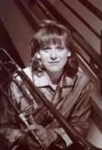
 |
Return to Tips for Trombone |
by Dr.
Deb Scott |
It is my opinion that by primarily focusing on the musical aspects of teaching, the fundamentals of good instrumental technique will follow. I have noticed in my own playing as well as my teaching, that when focusing on the musical product as the means to an end, the technical aspects fall into place.
Arnold Jacobs felt that the body is an efficient “computer” that does not need step by step instructions about how to solve a problem, but rather will come up with the best/most efficient solution on its own. In other words, one usually doesn’t have to tell one’s hand to reach out, grasp, and turn a door knob to open a door, but rather just “open the door.” The body’s reflexes handle the rest. The same principle applies to teaching or playing the trombone. If a student has a poor tone, the problem is not his equipment or even his embouchure (although his embouchure may technically be causing a bad sound) rather, it is his/her concept of sound. If a student has not focused on/listened to what is considered to be a good sound, that student may be perpetuating his/her own concept of sound that is simply underdeveloped.
The most important part of having a musical product is one’s concept of music or how a person internalizes the music. Without this concept, the music may be dull or lifeless. It may be technically correct in every avenue, but not be saying anything to the audience. It is an intangible that sets apart the technically uninspiring players from those that attain a high level of artisanship. Listening to other musicians is of primary importance. Having an array of personal experiences and emotions to draw from is also beneficial in my opinion. Musicianship is a combination of understanding of style, including tempo, rubato tempo, and articulations, dynamics, tone and timbre, and personal expression. If the concept for anyone of these is not met, the end result may not be pleasing.
My favorite teaching etudes are the Melodious Etudes by Bordogni/Rochut. With these tonal/accessible etudes, I can teach my students that it is okay to add their own personal expression by means of dynamics, rubato tempo, articulations, and/or tempo. Many times I have them develop a plot for these etudes, complete with characters and a storyline. This is very difficult for some of them and easier for others. Sometimes I have them work up the etude in a different style from that marked. When they actually “get in” to the music, the difference in the end product is striking. There is quick improvement on every level.
Other etude books that I like for the undergraduate include Couillaud’s Trente Etudes Modernes, Voxman’s Selected Studies, LaFosse’s School of Sight Reading and Style, Blazhevich/Fink Advanced Musical Etudes. All of these etude books focus on music. I know that there are other methods that are more popular such as the Arban method or the Kopprasch. I find that these are too technically bogged down and are not satisfying to learn or to listen to. My students make fine technical and musical progress without these. Also, I make sure that students are constantly exposed to solo works which can teach them more than most etude books. I use the same techniques mentioned above for the solos. They also have the opportunity to perform frequently (weekly) for their peers.
Of course, there are technical aspects that need to be worked on such as the ability to read tenor clef. I like to use Fink’s Introducing the Tenor or Alto Clef books.
Relaxation is an important part of being able to play your best; deep breathing can help with this process. I teach my students the importance of breathing deeply, taking a full breath and supporting their sound. Many times I have my students play their legato or technical studies without any tongue, keeping the air constant. Sometimes I have them buzz the mouthpiece to help with centering the pitch, since the mouthpiece is less forgiving than the horn in this respect.
Knowing and memorizing all major, minor, and chromatic scales will help develop mental patterns similar to the automatic reflexes mentioned above for opening a door. Buddy Baker’s Tenor Trombone Method is a thorough list of scales with good alternate positions that I like my students to know. Remington’s Warm up or Marstellar Basic Routines are good books for lipslurs, greatly improving flexibility. I believe that although there must be a thorough knowledge and understanding of scales, breathing, and flexibility, the primary focus should be on the music. Students should focus on making musical sounds, whether it be the most musical scale they can play or Grondhal’s Concerto.
| The Texas School Music Project is a source for ideas and information concerning pedagogical practices in the music classroom or rehearsal hall. The TSMP is a service provided to all music specialists by the faculty of the School of Music at Stephen F. Austin State University. For questions about this site contact [email protected]. Copyright © 2002-2019, The
School of Music at Stephen F. Austin State University |